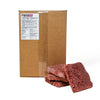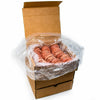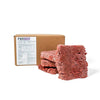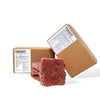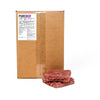Want to switch to a raw diet for your pet but you’re not sure about the safe practices for handling raw ingredients? This is a completely normal concern many have when wanting to transition their pet to a raw food diet. Preparing raw dog food may pose challenges, particularly when contrasted with the ease of serving dry food alternatives. However, with a proper understanding of raw food storage and handling techniques, the process becomes considerably more manageable.
Continue reading to discover the appropriate methods for managing raw dog food and providing your pet with a nutritious diet.
Storage and Management of Raw Dog Food
Storing raw dog food shows resemblance to storing conventional raw meat for human consumption. An important factor is ensuring the raw pet food remains frozen until ready for use. It makes the process easier in the long run if you portion out your required amounts for easier access when the food is ready for consumption. Any leftovers can be frozen, or alternatively, only a portion of the raw dog food can be thawed prior to serving until your pet needs or wants more.
Inattentive storage of raw dog food in the freezer carries the risk of contaminating other stored food. It may be easier to designate a distinct container for raw pet food, keeping it separate from other items. Naturally, meat becomes unsafe if exposed to temperatures above freezing for extended periods, with bacterial production increasing between 70-100°F. Maintaining a refrigerator temperature of 34-40°F is important to preserve the freshness of the raw food. Prior to refrigeration or freezing, ensure the raw food is sealed within the storage container, minimizing the air exposure.
Identifying Spoiled Food
Pet owners who are cautious about their pet’s health know how important it is to be cautious about food spoiling or becoming unsafe for their pet. It's imperative to discard raw dog food promptly under the following circumstances:
- Detection of a scent affiliated to spoiled meat or sour milk.
- An extended period of refrigerator or freezer malfunction.
- Oversight in freezing raw dog food, leaving it unrefrigerated overnight or for a long period of time.
- Observation of mold spores on the food.
- Identification of frostbite or cracking on the surface.
Serving Protocols and Sanitation Recommendations
Designate a specific bowl or plate for thawing and serving. Post feeding, thorough cleaning of the preparation area, utensils, and hands is imperative. This regimen aids in avoiding contamination, ensuring the health and safety of both your pet and family.
RawFedK9 emerged from years of commitment to pet wellness and health, originating from a vision of offering every pet owner a simpler, more cost-effective method to provide a prey model raw diet comprised of high-quality ingredients to their pets. Knowing the best ways to store and serve this diet makes for a seamless transition to a raw diet for your pet. Shop with RawFedK9 today to view our products and get started!

